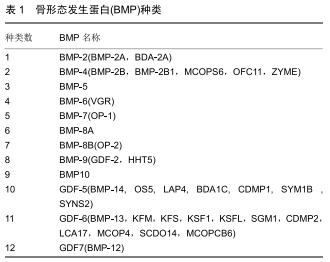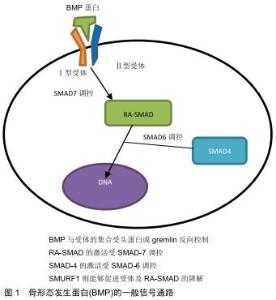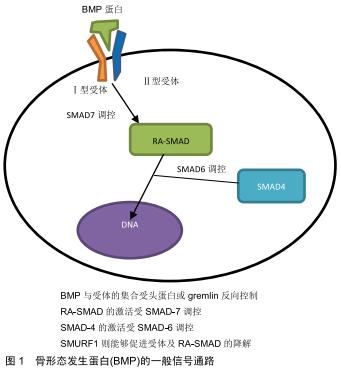Chinese Journal of Tissue Engineering Research ›› 2020, Vol. 24 ›› Issue (26): 4243-4250.doi: 10.3969/j.issn.2095-4344.2687
Previous Articles Next Articles
Assessments of bone morphogenetic proteins 2 and 7 in treating nonunion
Cong Kai1, Li Shanlong1, Wang Fei1, Cheng Hui1, Li Baitong2, Shang Jian1
1Department of Orthopaedics, the First Affiliated Hospital of Harbin Medical University, Harbin 150000, Heilongjiang Province, China; 2Department of Emergency Orthopedics, Gansu Hospital of Traditional Chinese Medicine, Lanzhou 730050, Gansu Province, China
-
Received:2019-10-12Revised:2019-10-19Accepted:2019-12-06Online:2020-09-18Published:2020-09-03 -
Contact:Shang Jian, MD, Chief physician, Department of Orthopaedics, the First Affiliated Hospital of Harbin Medical University, Harbin 150000, Heilongjiang Province, China -
About author:Cong Kai, Master candidate, Department of Orthopaedics, the First Affiliated Hospital of Harbin Medical University, Harbin 150000, Heilongjiang Province, China
CLC Number:
Cite this article
Cong Kai, Li Shanlong, Wang Fei, Cheng Hui, Li Baitong, Shang Jian.
Assessments of bone morphogenetic proteins 2 and 7 in treating nonunion [J]. Chinese Journal of Tissue Engineering Research, 2020, 24(26): 4243-4250.
share this article

狭义定义的骨形态发生蛋白 骨形态发生蛋白是转化生长因子β家族中的一员,目前已确定骨形态发生蛋白家族成员超过40个,但是根据骨形态发生蛋白的信号通路及其对细胞产生的影响,其中有12类骨形态发生蛋白在基因的表达中,SMAD1,5和8通路过程中末端丝氨酸残基被磷酸化,作用于成骨细胞特异性转录因子RUNX2、骨桥蛋白和骨钙蛋白促进成骨表达[4]。文章将之称为狭义定义的骨形态发生蛋白,见表1。骨形态发生蛋白配体经过多步骤的加工、翻译及修饰后,通过半胱氨酸结合,形成由二硫键连接的同二聚体。目前,可发现的骨形态发生蛋白在骨骼内存在形式仅为同型二聚体,但体外实验证实了异二聚体的存在,如骨形态发生蛋白2/7、骨形态发生蛋白2/6及骨形态发生蛋白4/7[5-7],这些异二聚体显示出了优于同型二聚体的生物活型,但是产生这种增强活性的原因尚未被阐述清楚。 "

|
[1] URIST MR. Bone: formation by autoinduction. Science. 1965;150 (3698):893-899.
[2] URIST MR, STRATES BS. The classic: bone morphogenetic protein. Clin Orthop Relat Res. 2009;467(12):3051-3062.
[3] MURRAY SS, BROCHMANN MURRAY EJ, WANG JC, et al. The history and histology of bone morphogenetic protein. Histol Histopathol. 2016;31(7):721-732.
[4] WANG M, LI J, YE Y, et al. SHED-derived conditioned exosomes enhance the osteogenic differentiation of PDLSCs via Wnt and BMP signaling in vitro. Differentiation. 2019;111:1-11.
[5] LOOZEN LD, VANDERSTEEN, A, KRAGTEN, AH, et al. Bone formation by heterodimers through non-viral gene delivery of BMP-2/6 and BMP-2/7. Eur Cell Mater. 2018;35:195-208.
[6] KAITO T, MORIMOTO T, MORI Y, et al. BMP-2/7 heterodimer strongly induces bone regeneration in the absence of increased soft tissue inflammation. Spine J. 2018;18(1):139-146.
[7] NEUGEBAUER JM, KWON S, KIM HS, et al. The prodomain of BMP4 is necessary and sufficient to generate stable BMP4/7 heterodimers with enhanced bioactivity in vivo. Proc Natl Acad Sci U S A. 2015;112(18):E2307-E2316.
[8] KATAGIRI T, WATABE T. Bone morphogenetic proteins. Cold Spring Harb Perspect Biol. 2016,8(6):a021899.
[9] ZHANG YE. Non-smad signaling pathways of the TGF-β family. Cold Spring Harb Perspect Biol. 2017;9(2):a022129.
[10] BAO LR, ZHAO WQ, LIN T, et al. miRNA profile of the human dental pulp cells during odontoblast differentiation induced by BMP-2. Shanghai Kou Qiang Yi Xue. 2017;26(5):476-483.
[11] KIM BG, LEE JH, AHN JM, et al. 'Two-stage double-technique hybrid (TSDTH)' identification strategy for the analysis of BMP2-induced transdifferentiation of premyoblast C2C12 cells to osteoblast. J Proteome Res. 2009;8(10):4441-4454 .
[12] HASSEL S, SCHMITT S, HARTUNG A, et al. Initiation of Smad-dependent and Smad-independent signaling via distinct BMP-receptor complexes. J Bone Joint Surg Am. 2003;85-A Suppl 3:44-51.
[13] NOHE A, HASSEL S, EHRLICH M, et al. The mode of bone morphogenetic protein (BMP) receptor oligomerization determines different BMP-2 signaling pathways. J Biol Chem. 2002;277(7):5330-5338.
[14] GUZMAN A, ZELMAN-FEMIAK M, BOERGERMANN JH, et al. SMAD versus non-SMAD signaling is determined by lateral mobility of bone morphogenetic protein (BMP) receptors. J Biol Chem. 2012;287(47):39492-39504.
[15] CHEN B, LI B, QI YJ, et al. Enhancement of tendon-to-bone healing after anterior cruciate ligament reconstruction using bone marrow-derived mesenchymal stem cells genetically modified with bFGF/BMP2. Sci Rep. 2016;6:25940.
[16] HE J, HAN X, WANG S, et al. Cell sheets of co-cultured BMP-2-modified bone marrow stromal cells and endothelial progenitor cells accelerate bone regeneration in vitro. Exp Ther Med. 2019;18(5):3333-3340.
[17] ROY S, ZHUANG Y, Paradoxical role of Id proteins in regulating tumorigenic potential of lymphoid cells. Front Med. 2018,12(4): 374-386.
[18] LOCKLIN RM, RIGGS BL, HICOK KC, et al.Assessment of gene regulation by bone morphogenetic protein 2 in human marrow stromal cells using gene array technology. J Bone Miner Res. 2001,16(12):2192-204.
[19] HAYASHI Y, HSIAO EC, SAMI S, et al. BMP-SMAD-ID promotes reprogramming to pluripotency by inhibiting p16/INK4A-dependent senescence. Proc Natl Acad Sci USA. 2016;113(46):13057-13062 .
[20] JIA Y, WANG, Z, ZANG, A, et al. Tetramethylpyrazine inhibits tumor growth of lung cancer through disrupting angiogenesis via BMP/Smad/Id-1 signaling. Int J Oncol. 2016;48(5):2079-2086.
[21] SHIN M, OHTE S, FUKUDA T, et al. Identification of a novel bone morphogenetic protein (BMP)-inducible transcript, BMP-inducible transcript-1, by utilizing the conserved BMP-responsive elements in the Id genes. J Bone Miner Metab. 2013;31(1):34-43.
[22] LEE KM, PARK KH, HWANG JS, et al. Inhibition of STAT5A promotes osteogenesis by DLX5 regulation. Cell Death Dis. 2018; 9(11):1136.
[23] CAO Y, LV Q, LV C. MicroRNA-153 suppresses the osteogenic differentiation of human mesenchymal stem cells by targeting bone morphogenetic protein receptor type II. Int J Mol Med. 2015; 36(3):760-766.
[24] MIYAUCHI Y, MIYAMOTO T. Suppressive effects for osteoclastogenesis regulated by RANKL signal. Clin Calcium. 2011;21(8):1141-1147.
[25] ZHANG J, ZHANG W, DAI J, et al. Overexpression of Dlx2 enhances osteogenic differentiation of BMSCs and MC3T3-E1 cells via direct upregulation of Osteocalcin and Alp. Int J Oral Sci. 2019;11(2):12.
[26] LUTTRELL LM, DAR MS, GESTY-PALMER D, et al. Transcriptomic characterization of signaling pathways associated with osteoblastic differentiation of MC-3T3E1 cells. PLoS One. 2019;14(1):e0204197 .
[27] VANYAI HK, GARNHAM A, MAY RE, et al. MOZ directs the distal-less homeobox gene expression program during craniofacial development. Development. 2019 doi: 10.1242/dev.175042.
[28] SUN S, YU M, FAN Z, et al. DLX3 regulates osteogenic differentiation of bone marrow mesenchymal stem cells via Wnt/β-catenin pathway mediated histone methylation of DKK4. Biochem Biophys Res Commun. 2019;516(1):171-176.
[29] LI Y FAN L, HU J, et al. MiR-26a Rescues bone regeneration deficiency of mesenchymal stem cells derived from osteoporotic mice. Mol Ther. 2015;23(8):1349-1357.
[30] SINGH M, DEL CARPIO-CANO FE, MONROY MA, et al. Homeodomain transcription factors regulate BMP-2-induced osteoactivin transcription in osteoblasts. J Cell Physiol. 2012; 227(1):390-399.
[31] YANG L, GE D, CAO X, et al. MiR-214 Attenuates osteogenic differentiation of mesenchymal stem cells via targeting FGFR1. Cell Physiol Biochem. 2016;38(2):809-820.
[32] DENG Y, WU S, ZHOU H, et al. Effects of a miR-31, Runx2, and Satb2 regulatory loop on the osteogenic differentiation of bone mesenchymal stem cells. Stem Cells Dev. 2013;22(16): 2278-2286.
[33] HUANG J, MENG Y, LIU Y, et al. MicroRNA-320a regulates the osteogenic differentiation of human bone marrow-derived mesenchymal stem cells by targeting HOXA10. Cell Physiol Biochem. 2016;38(1):40-48.
[34] HALCSIK E, FORNI MF, FUJITA A, et al. New insights in osteogenic differentiation revealed by mass spectrometric assessment of phosphorylated substrates in murine skin mesenchymal cells. BMC Cell Biol. 2013;14:47.
[35] JUN JH, YOON WJ, SEO SB, et al. BMP2-activated Erk/MAP kinase stabilizes Runx2 by increasing p300 levels and histone acetyltransferase activity. J Biol Chem. 2010;285(47): 36410-36419.
[36] KOSEKI T, GAO Y, OKAHASHI N, et al. Role of TGF-beta family in osteoclastogenesis induced by RANKL. Cell Signal. 2002;14(1): 31-36.
[37] BARCAK EA, BEEBE MJ, Bone morphogenetic protein: is there still a role in orthopedic trauma in 2017? Orthop Clin North Am. 2017;48(3):301-309.
[38] CATERINI R, POTENZA V, IPPOLITO E, et al. Treatment of recalcitrant atrophic non-union of the humeral shaft with BMP-7, autologous bone graft and hydroxyapatite pellets. Injury. 2016;47 Suppl 4:S71-S77.
[39] SINGH R, BLEIBLEH S, KANAKARIS NK, et al. Upper limb non-unions treated with BMP-7: efficacy and clinical results. Injury. 2016;47 Suppl 6:S33-S39.
[40] OLLIVIER M, GAY AM, CERLIER A, et al. Can we achieve bone healing using the diamond concept without bone grafting for recalcitrant tibial nonunions? Injury. 2015;46(7):1383-1388.
[41] MURENA L, CANTON G, VULCANO E, et al. Treatment of humeral shaft aseptic nonunions in elderly patients with opposite structural allograft, BMP-7, and mesenchymal stem cells. Orthopedics. 2014;37(2):e201-e206.
[42] LOWERY JW, ROSEN V. Bone morphogenetic protein-based therapeutic approaches. Cold Spring Harb Perspect Biol. 2018. doi: 10.1101/cshperspect.a022327.
[43] BISHOP, JA, PALANCA, AA, BELLINO, MJ, et al. Assessment of compromised fracture healing. J Am Acad Orthop Surg. 2012; 20(5):273-282.
[44] HAK, DJ, Editorial on "Epidemiology of fracture nonunion in 18 human bones". Ann Transl Med. 2017;5(Suppl 1):S19.
[45] NICODEMO A, CAPELLA M, DEREGIBUS M, et al. Nonunion of a sacral fracture refractory to bone grafting: internal fixation and osteogenic protein-1 (BMP-7) application. Musculoskelet Surg. 2011;95(2):157-161.
[46] HACKL S, HIERHOLZER C, FRIEDERICHS J, et al. Long-term outcome following additional rhBMP-7 application in revision surgery of aseptic humeral, femoral, and tibial shaft nonunion. BMC Musculoskelet Disord. 2017;18(1):342.
[47] CECCHI S, BENNET SJ, ARORA M, Bone morphogenetic protein-7: Review of signalling and efficacy in fracture healing. J Orthop Translat. 2016;4:28-34.
[48] MOGHADDAM-ALVANDI A, ZIMMERMANN G, BÜCHLER A, et al. Results of nonunion treatment with bone morphogenetic protein 7 (BMP-7). Unfallchirurg. 2012;115(6):518-526.
[49] TRESSLER MA, RICHARDS JE, SOFIANOS D, et al. Bone morphogenetic protein-2 compared to autologous iliac crest bone graft in the treatment of long bone nonunion. Orthopedics. 2011; 34(12):e877-e884.
[50] ABLOVE RH, ABRAMS SS. The use of BMP-2 and screw exchange in the treatment of scaphoid fracture non-union. Hand Surg. 2015;20(1):167-171.
[51] BRANNAN PS, GASTON RG, LOEFFLER BJ, et al. Complications with the use of BMP-2 in scaphoid nonunion surgery. J Hand Surg Am. 2016;41(5):602-608.
[52] CONWAY JD, SHABTAI L, BAUERNSCHUB A, et al. BMP-7 versus BMP-2 for the treatment of long bone nonunion. Orthopedics. 2014;37(12):e1049-e1057.
[53] HAUBRUCK P, TANNER MC, VLACHOPOULOS W, et al. Comparison of the clinical effectiveness of Bone Morphogenic Protein (BMP) -2 and -7 in the adjunct treatment of lower limb nonunions. Orthop Traumatol Surg Res. 2018;104(8):1241-1248.
[54] HISSNAUER TN, STIEL N, BABIN K, et al. Bone morphogenetic protein-2 for the treatment of congenital pseudarthrosis of the tibia or persistent tibial nonunion in children and adolescents: a retrospective study with a minimum 2-year follow-up. J Mater Sci Mater Med. 2017;28(4):60.
[55] PAPANNA MC, SALDANHA KA, KURIAN B, et al. The use of recombinant morphogenic protein-2(rhBMP-2) in children undergoing revision surgery for persistent non-union. Strategies Trauma Limb Reconstr. 2016;11(1):53-58.
[56] RICHARDS BS, OETGEN ME, JOHNSTON CE. The use of rhBMP-2 for the treatment of congenital pseudarthrosis of the tibia: a case series. J Bone Joint Surg Am. 2010;92(1):177-185.
[57] RITTING AW, WEBER EW, LEE MC. Exaggerated inflammatory response and bony resorption from BMP-2 use in a pediatric forearm nonunion. J Hand Surg Am. 2012;37(2):316-321.
[58] GIANNOUDIS PV, KANAKARIS NK, DIMITRIOU R, et al. The synergistic effect of autograft and BMP-7 in the treatment of atrophic nonunions. Clin Orthop Relat Res. 2009;467(12): 3239-3248. [59]AGRAWAL V, SINHA M, A review on carrier systems for bone morphogenetic protein-2. J Biomed Mater Res B Appl Biomater. 2017;105(4):904-925. |
| [1] | Liang Yan, Zhao Yongfei, Xu Shuai, Zhu Zhenqi, Wang Kaifeng, Liu Haiying, Mao Keya. Imaging evaluation of short-segment fixation and fusion for degenerative lumbar scoliosis assisted by highly selective nerve root block [J]. Chinese Journal of Tissue Engineering Research, 2021, 25(9): 1423-1427. |
| [2] | Geng Yao, Yin Zhiliang, Li Xingping, Xiao Dongqin, Hou Weiguang. Role of hsa-miRNA-223-3p in regulating osteogenic differentiation of human bone marrow mesenchymal stem cells [J]. Chinese Journal of Tissue Engineering Research, 2021, 25(7): 1008-1013. |
| [3] | Liu Lihua, Sun Wei, Wang Yunting, Gao Fuqiang, Cheng Liming, Li Zirong, Wang Jiangning. Type L1 steroid-induced osteonecrosis of the femoral head through femoral head and neck junction decompression by fenestration: a single-center prospective clinical study [J]. Chinese Journal of Tissue Engineering Research, 2021, 25(6): 906-911. |
| [4] | Yuan Xinping, Shao Yanbo, Wu Chao, Wang Jianling, Tong Liangcheng, Li Ying. Accuracy of target bone segments in personalized differential modeling and simulation of CT scanning parameters at fracture end [J]. Chinese Journal of Tissue Engineering Research, 2021, 25(6): 912-916. |
| [5] | Li Shibin, Lai Yu, Zhou Yi, Liao Jianzhao, Zhang Xiaoyun, Zhang Xuan. Pathogenesis of hormonal osteonecrosis of the femoral head and the target effect of related signaling pathways [J]. Chinese Journal of Tissue Engineering Research, 2021, 25(6): 935-941. |
| [6] | Hua Haotian, Zhao Wenyu, Zhang Lei, Bai Wenbo, Wang Xinwei. Meta-analysis of clinical efficacy and safety of antibiotic artificial bone in the treatment of chronic osteomyelitis [J]. Chinese Journal of Tissue Engineering Research, 2021, 25(6): 970-976. |
| [7] | Zhang Bin, Sun Lihua, Zhang Junhua, Liu Yusan, Cui Caiyun. A modified flap immediate implant is beneficial to soft tissue reconstruction in maxillary aesthetic area [J]. Chinese Journal of Tissue Engineering Research, 2021, 25(5): 707-712. |
| [8] | Liu Bo, Chen Xianghe, Yang Kang, Yu Huilin, Lu Pengcheng. Mechanism of DNA methylation in exercise intervention for osteoporosis [J]. Chinese Journal of Tissue Engineering Research, 2021, 25(5): 791-797. |
| [9] | Deng Zhenhan, Huang Yong, Xiao Lulu, Chen Yulin, Zhu Weimin, Lu Wei, Wang Daping. Role and application of bone morphogenetic proteins in articular cartilage regeneration [J]. Chinese Journal of Tissue Engineering Research, 2021, 25(5): 798-806. |
| [10] | Li Chenjie, Lü Linwei, Song Yang, Liu Jingna, Zhang Chunqiu. Measurement and statistical analysis of trabecular morphological parameters of titanium alloy peri-prosthesis under preload [J]. Chinese Journal of Tissue Engineering Research, 2021, 25(4): 516-520. |
| [11] | Ye Haimin, Ding Linghua, Kong Weihao, Huang Zutai, Xiong Long. Role and mechanism of hierarchical microchanneled bone scaffolds in promoting osteogenesis and angiogenesis [J]. Chinese Journal of Tissue Engineering Research, 2021, 25(4): 621-625. |
| [12] | Li Xiaozhuang, Duan Hao, Wang Weizhou, Tang Zhihong, Wang Yanghao, He Fei. Application of bone tissue engineering materials in the treatment of bone defect diseases in vivo [J]. Chinese Journal of Tissue Engineering Research, 2021, 25(4): 626-631. |
| [13] | He Jie, Chang Qi. Biological reconstruction of large bone defects after resection of malignant tumor of extremities [J]. Chinese Journal of Tissue Engineering Research, 2021, 25(3): 420-425. |
| [14] | Xing Hao, Zhang Yonghong, Wang Dong. Advantages and disadvantages of repairing large-segment bone defect [J]. Chinese Journal of Tissue Engineering Research, 2021, 25(3): 426-430. |
| [15] | Xie Chengxin, Wang Wei, Wang Chenglong, Li Qinglong, Yin Dong. Systematic review and meta-analysis of bone morphogenetic protein for the treatment of acute tibial fracture [J]. Chinese Journal of Tissue Engineering Research, 2021, 25(3): 486-492. |
| Viewed | ||||||
|
Full text |
|
|||||
|
Abstract |
|
|||||

